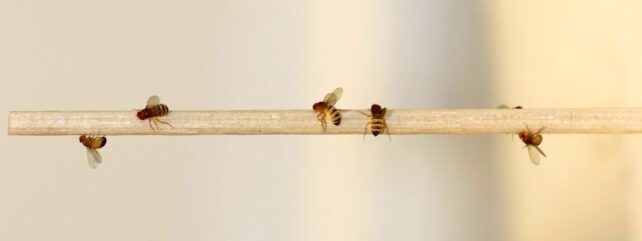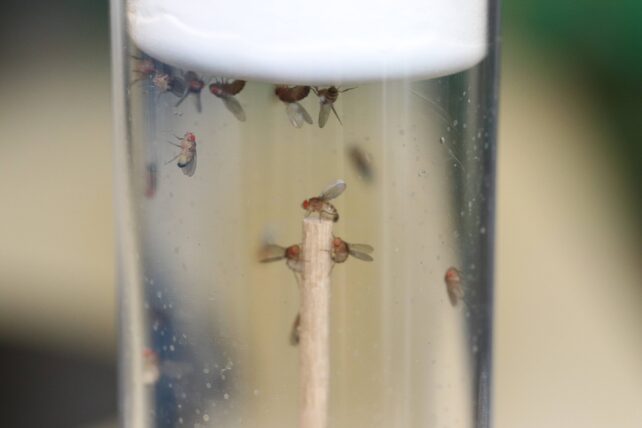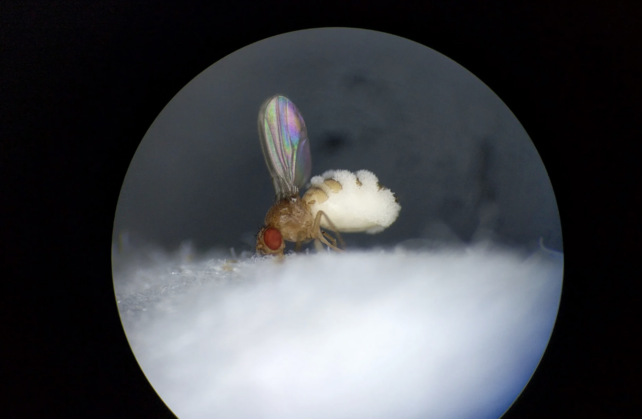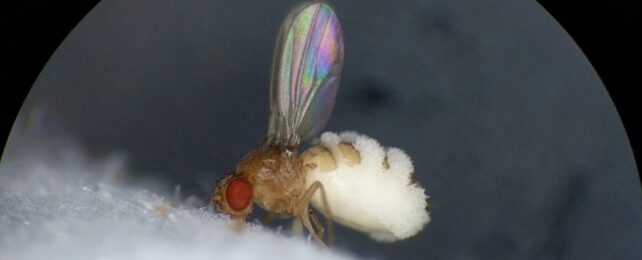A fungal parasite that turns ordinary flies into fearless climbers has finally been caught plucking the neurological strings of its host, triggering a burst of activity that drives them to find an elevated spot before dying.
Conducting experiments on fruit flies (Drosophila melanogaster) infected with Entomophthora muscae, researchers from Harvard University in the US have found the internal clock and hormone-producing systems of the fly's brain are involved in propelling the fungi's host to a lofty final resting place.
Known as summiting, this real-life horror movie behavior ultimately allows their parasitic pilots to infect more hosts. Perched far from the ground, they stretch out their proboscises and release a sticky droplet that glues them to the surface, lifting their wings dramatically above their bodies in a striking zombie pose that exposes the fungal spores to the air.
'Zombie' fly behavior has fascinated scientists for decades with the mechanisms responsible for this activity largely a mystery. Until now, no one has even observed zombie flies in their last hours of life.
"We found that summiting is not about climbing," says lead author Carolyn Elya, a cell biologist and self-described zombiologist; "it's actually this burst of locomotor activity that starts about two and a half hours before the flies die."
Identifying summiting flies in real time was difficult, so the researchers used machine learning to assist. It alerted them to observe and collect tissue from summiting flies, providing a tool to measure the behavior and identify genes and neurons involved.

Experiments revealed a burst of speed in zombie flies in the 2.5 hours before they died. Tissue examination indicated fungal cells mainly target specific areas of the fly's brain tasked with managing circadian and neurosecretory systems, leading to the release of a specific hormone.
"When we silenced these neurons the flies were really bad at summiting," Elya says.
"We think the fungus is actually driving the activity of these neurons in order to drive the release of this hormone, which is causing the flies to have this burst of locomotor activity."
What's more, they found that E. muscae infection increases the permeability of the blood-brain barrier, allowing substances in the fly's bloodstream to affect its brain.
"We think this could be important for the way that the fungus is driving behavioral changes," Elya says.
The researchers found differences in the levels of certain blood compounds between summiting and control flies. Transfusing the blood of summiting flies into control flies caused a burst of movement, indicating that substances in the blood contribute to summiting behavior.
"We've shown that there's at least the partial ability to recapitulate this summiting behavior just by transferring fly blood," explains Elya.

E. muscae's zombie invasion starts when an infectious spore lands on a fly host. Using enzymes to break through the cuticle, the fungus enters its host and 'eats' it from the inside out.
This gory digestion process starts with the fly's nutrient stores, preserving the nervous system, muscles, gut, and gonads. The fly can eat, breed, and generally enjoy being a fly during this time.
The fungus eventually begins its escape by feeding on the digestive system and gonads while the fly is very much alive. It then triggers the cascade of wacky actions that send it scrambling, culminating in the death of its fly host.
There's a method to the madness; fungal growth in the fly's proboscis has a glue-like effect that renders the insect immobile. The fly's wings rise up and away from its back at the time of its demise to allow the fungus an easy exit and promote its onward journey.
"The fungus jumps to the new host by forming very specialized and temporary structures that burst through the fly's skin and shoots spores into the environment that are only good for a handful of hours," explains Elya.
"It's a fleeting process, so an advantageous position is everything to survival."
You can probably picture in your nightmares how the fly's fixed, elevated deathbed allows the speedy spore-shooting cannons to reach maximum new hosts. As if that's not horrific enough, the fungus has other tricks it uses to spread its spores, none with a G rating.

"The host circadian network is involved in mediating the increased locomotor activity that we now understand to define summiting," the authors conclude.
"However, our data do not speak to how the timing of this behavior is determined in the zombie-fly system."
So that's some questions answered, but more research is needed to determine factors like if E. muscae can keep time, which chemicals are involved, and if fungal cells must physically reach the brain to cause a full summiting response.
"There are still a lot of open questions here," Elya says, "what the fungus is doing is still a mystery."
The research was published in eLife.
